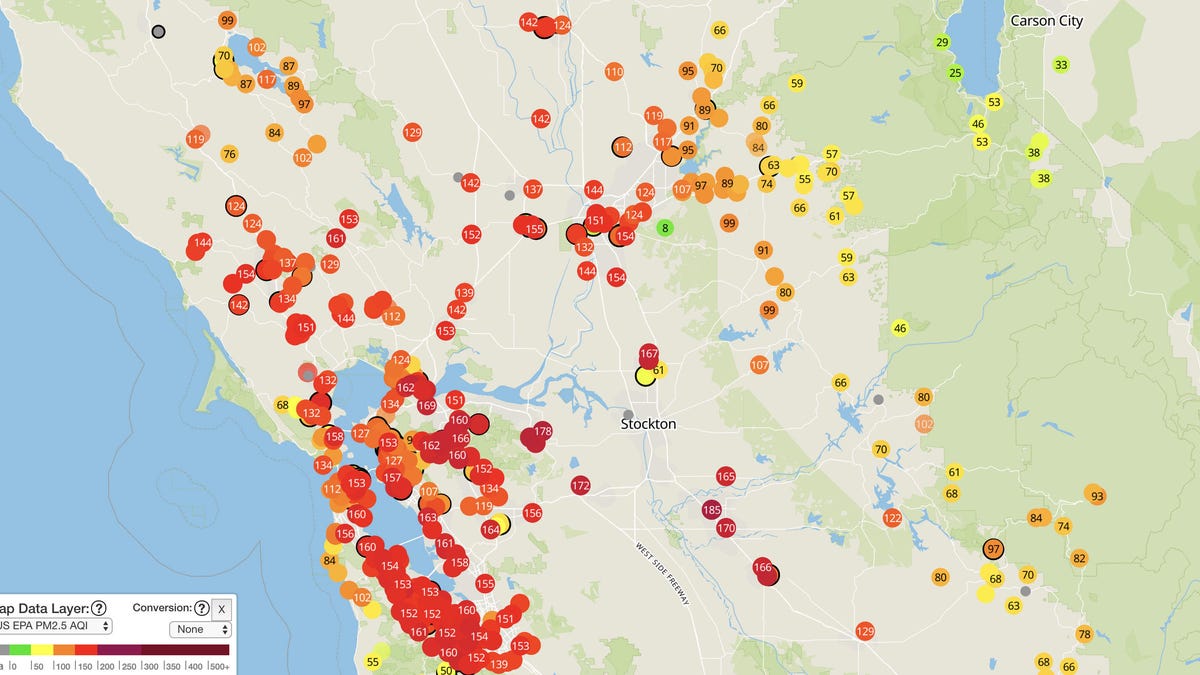California fires boost interest in PurpleAir's pollution sensors
The company's map displays air quality around the world.

PurpleAir's air quality sensors feed data into a map anyone can see. This screenshot shows bad air quality in the San Francisco Bay Area and the number of people who've installed the sensors.
The Camp Fire has killed 81 people, burned more than 153,000 acres, destroyed at least 13,000 homes and blanketed millions of San Francisco Bay Area residents in unhealthy air. Smoke from the disaster -- bad enough to shut schools and trigger warnings to stay indoors -- drifted over the Bay Area and its tech-savvy population for more than a week.
That's prompted interest in PurpleAir, a Draper, Utah-based company that makes an air quality sensor about the size of two tuna cans. Since the fire began on Nov. 8, the company has sold about 500 of the Wi-Fi-connected canisters, each of which sends measurements back to PurpleAir.
The company, which has more 2,000 sensors at homes around the world, uses the data to compile a global map of air quality that anyone can check online. Traffic to the map increased by a factor of about 100 during the fire, he said.
"Our sales team is volcanoes and wildfires," PurpleAir founder Adrian Dybwad said in an interview, adding that this year's Kilauea eruption in Hawaii also spurred demand. When the events end, sales settle back down, but to a higher level than before the incidents, he said.
PurpleAir offers an interesting new twist on internet-of-things gadgets and citizen science projects. You have to pay for the device, whose data PurpleAir exploits. But you also get to benefit from the data that everybody else's sensors provide, giving you air quality information for places you work and visit, not just your home.
'I am a data geek'
Louis Gray, a Google employee whose childhood home in Paradise, California, was burned in the Camp Fire, is one new customer.
"I bought it because the air has been awful all of the last two weeks, and there wasn't a sensor super close to us," Gray said. "And because I am a data geek, so why not get one? It was super easy to set up."
PurpleAir sensor can measure air quality indoors or outdoors.
PurpleAir's outdoor sensor costs $229 and beams data over Wi-Fi. The company also makes a more sophisticated outdoor model that records data to a memory card for $259. A $179 indoor model that lacks weatherproofing is also available. All the models use a laser-and-detector system to spot flecks of particulate matter that are invisible to the human eye but can cause a haze of smoke and pollution in quantity.
Typical customers include individuals curious about things like the best time to exercise or the effect of a neighbor's fireplace. Clean-air activists, agencies and university researchers are also customers.
PurpleAir records your sensor's data -- humidity and temperature, too, by the way -- so you can access it later. You can also share the data on the PurpleAir map and with the Weather Underground service.
Different from US government measurements
The US Environmental Protection Agency measures this sort of thing, too. Its Air Quality Index reports levels of particulate matter with a diameter of about 2.5 microns. That's 2.5 millionths of a meter, something less than 1/40th the width of a human hair -- small enough to make its way from your lungs into your bloodstream.
High particulate pollution levels can cause problems with your heart and breathing, the EPA warns.
The government AQI is based on the mass of particles caught in a filter for a given volume of air drawn through the gauge. The instruments cost tens of thousands of dollars and are relatively rare, but they establish the official AQI scores on which medical studies are based.
Before-and-after satellite photos from DigitalGlobe show the devastation of the Camp Fire in northern California. Smoke from it blew over the San Francisco Bay Area for a week, causing unhealthy conditions that canceled schools and kept people indoors.
PurpleAir's laser-based systems often produce a somewhat different score, Dybwad said. That's because the laser-based sensors count the number of particles, not their mass. A given number of denser particles, such as gravel dust, weigh more than the same number of than lighter ones, such as smoke particles.
In addition, PurpleAir sensors send frequent updates compared to EPA figures that are based on averages over a longer time span. Often the PurpleAir network will spot increases and decreases sooner than the EPA data shows it, Dybwad said.
Measuring gravel dust in Utah
Dybwad, who lives in the Salt Lake City area in Utah, founded PurpleAir in 2015 after becoming curious about local dust.
"There's a gravel pit behind our house. Every day we'd watch dust blowing across the town below us and wonder much dust these people were subjected to," he said. There wasn't a sensor -- at least nothing affordable -- on the market, so he tapped into his background in computers and electronics, and built his own.
The company is now racing to keep up with demand triggered by the recent California fires, hiring contractors to build the small devices. PurpleAir is working on a new design that should be cheaper and easier to manufacture and repair, Dybwad said.
So the silver lining from California's fires is that we'll all be able to benefit from the PurpleAir air quality maps.
"It makes our business more certain. It makes us more able to move into new facility to do the manufacturing. It helps us to pay the bills on the website," Dybwad said. "It gives us more sense of surety that we're going to be here tomorrow."
CNET's Holiday Gift Guide: The place to find the best tech gifts for 2018.
Best Black Friday 2018 deals: The best discounts we've found so far.

